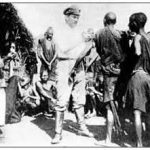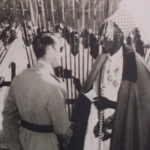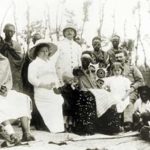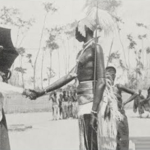The Reassertion Of Central Control
Towardthe end of 1931, the Belgian administration made plans to replace Umwami Musinga. The Europeans had found their efforts to “modernize” the Rwandan polity hampered by Musinga’s stead-fast loyalty to ritual obligations and practices. The king was unwilling to adopt the Christian religion, he lacked formal education, and he was suspicious of the Belgian authority. European missionaries, particularly Mgr. Léon Classe, wished to install a younger man who wouldbe more amenable to Catholicism; Classe put pressure on Belgian administrators, some of whom were receptive to the idea that a younger king
sympathetic to Western beliefs would more actively cooperate in the colonial enterprise. So it was that on November 12, 1931 the Governor of Ruanda-Urundi decreed that Musinga’s reign had come to an end. Two days later, Musinga and a large caravan set out from Nyanza toward Kamembe, in Kinyaga, where the deposed king was to live out his exile; on November 16 Musinga’s son Rudahigwa was enthroned as Umwami Mutara Rudahigwa. During the ceremonies at Nyanza, one of the chiefs with a major role was Rwagataraka, who delivered an Ikinyarwanda translation of the Governor’s speech.
The choice of Kinyaga for the residence-in-exile was significant. Musinga was informed that should he cause any difficulties, he would be sent west of Lake Kivu, outside Rwanda entirely. Moreover it was thought that Rwagataraka, a known rival of the deposed king, would keep a watchful eye on his enemy. Rwagataraka’s career had reached its apogee. So influential was he that Kinyagans thought he wished to be king, and some even believed he would be the successor to Musinga.
But during the next ten years Rwagataraka witnessed a gradual decime in his power. After a conflict with the A.T. at Cyangugu in 1934, Rwagataraka was “punished” by the reduction of his domain. The area north of the Mwaga River was removed frorn Impara to become Cyesha Chiefdom, and Munyakayanza (Abagereka lineage, Abeega clan) became its chief, responsible to the kingm This change in chief dom boundaries in fact restored an earlier administrative division from Rwidegembya’s era, and corresponded with cultural differences between the two areas. The partition of Rwagataraka’s domain was also a logical extension of the Belgian program to standardize administrative units.
Whatever the logic of the policy, it did nothing to soften the impact for Rwagataraka. Aside from losing territory and revenue, Rwagataraka lost control over appointments of subchiefs in Cyesha—an important form of patronage. The measure forced him to vacate his principal residence at Ishara Peninsula and move south to Shangi, the new center of the Impara chiefdom. Yet the creation of Cyesha was more a symbolic action than a systematic reordering of power relationships. Even without the area north of the Mwaga, Rwagataraka still controlled more land and population than all the other chiefs in Kinyaga. The number of subchiefs under him in 1938 was more than double the total number of subchiefs in Cyesha and Matira chiefdoms, and the number of tax-payers was at least half again as large as the number of taxpayers elsewhere in the region. Rwagataraka’s power was diminished, but it was by no means destroyed.
Despite the erosion of his influence, the local empire constructed by Rwagataraka was dismantled only after his death (1941) when Umwami Rudahigwa moved to install his own men in Kinyaga. In 1942, Impara chief dom was subdivided again by the creation of Bukunzi-Busoozo-Bugarama Chiefdom, with Etiènne Gitefano, an Ndugan of the Abaya lineage (Abanyiginya clan) as chief. Joseph Bideri—a member of the Abahindiro lineage (Abanyiginya clan) and one of Rudahigwa’s favorites—took charge of the remaining portion of Impara chiefdom. Scarcely a year later, Rwagataraka’s son who had commanded briefly in Cyesha, was deposed in favor of a Kinyagan, Ambroise Gakooko, of the Abanama lineage (Abanyiginya clan). Thus, by the end of 1943, three of the four chief doms in Kinyaga were led by men of the Abanyiginya clan, and all of these were members of lineages claiming descent from a former king. The only chief not from a royal one was Biniga, chief of Abiiru, who had been appointed during Rwagataraka’s time; he was a member of the Abahanya lineage (Abeega clan).
This imposition of Ndugan chiefs was part of a general program pursued by Rudahigwa to restore members of the Abanyiginya clan to power. It was, so to speak, his “revenge” against the Abeega for their
murder of Rutarindwa and their treatment of his father Musinga. The unification of Kinyaga achieved earlier under Rwagataraka facilitated these efforts by Rudahigwa. Rwagaaraka had used central Rwandan techniques of imposing and consolidating his control; once the administrative structures of hierarchical command and cfientship had been established, it was easier for other central chiefs to take over their operation.
The chiefs appointed by Rudahigwa, perpetuating patterns of rule forged by their predecessors, weeded out incumbent lower officials to make room for their personal followers. One important result at the local level, particularly in the two Kinyagan chief doms commanded by Ndugans (Impara and Bukunzi-Busoozo-Bugarama.), was an increased percentage of outsiders (non-Kinyagans) as subchiefs. Even where Kinyagans were appointed as subchiefs, they were rarely assigned to their natal hills. The trend was reinforced by the Belgian program (which began in the late 1920s) of replacing uneducated subchiefs with literate abakaraani. In the 1930s, after the Ecole des Batutsi at Cyangugu was closed, few Kinyagans obtained access to training in administration (and therefore could not qualify for chiefly posts); while the relative proportions of Ndugans who studied increased.
The imposition of Ndugan chiefs and subchiefs in greater numbers during the reign of Rudahigwa often provoked severe conflicts, contributing to rural discontent. Ndugans attempted to impose clientship and customs from the center; the local population, unaccustomed to such practices, resented these efforts. These changes generated particularly strong reactions in the former kingdoms ofBukunzi and Busoozo, where people had preserved their autonomy well into the colonial period. Noncooperation on the part of the population was not simply a manifestation of cultural values posing an obstacle to modernization, as some of the political modernization theories of the 1960s might lead us to believe. Colonial statebuilding in Rwanda reinforced and consolidated a process of peasantization, which for many areas of the country had not begun until the reign 0f Rwabugiri at the end of the nineteenth century or, for regions such as Buknnzi and Busoozo, even later than that. From the perspective of individual rural dwellers, increased government penetration under colonial rule implied a profound rearrangement of opportunities for political and social mobility and changes in security of access to basic economic goods such as land. Understandably, nonruling groups in Rwanda evaluated (and responded to) dual colonial rude in terms of how these changes affected their lives.
https://uk.amateka.net/the-reassertion-of-central-control/https://uk.amateka.net/wp-content/uploads/2020/05/musinga.jpghttps://uk.amateka.net/wp-content/uploads/2020/05/musinga-150x150.jpgChanges and ColonialismTowardthe end of 1931, the Belgian administration made plans to replace Umwami Musinga. The Europeans had found their efforts to 'modernize' the Rwandan polity hampered by Musinga's stead-fast loyalty to ritual obligations and practices. The king was unwilling to adopt the Christian religion, he lacked formal education, and he...BarataBarata rpierre@ikaze.netAdministratorAMATEKA | HISTORY OF RWANDA




